|
Note the four blade spinner, indented lower grille, and hood lift handles.
|
Note the spinner now has three blades and the two lower grilles are flush mounted.
|
Note the spinner is gone, and the new grille is giving us signs of what will be coming in 1953.
|
1950
& 51 would become the years of the Studebaker “Bullet-Nose”. This design is so iconic in Studebaker history, that lots of people
think the theme lasted for more years then it did. Because of the
radical departure from the late forties design, the 1950 Studebaker
looks like an all new car design. But, it is actually just a face
lift, with new sheet metal from the cowl forward, new rear fenders,
and new tail lights. The main portions of the body, doors, and frame
remained nearly the same until 1953. Referred to by the sales ad
people as the “Next Look,” the design had been planned for a
1949 release, so production for the 1950 models started in early
August 1949 instead of September. The
spinner had been under consideration for years with the first
sketches seen as early as 1941 and an actual mock-up produced in
1943. The idea preceded the 1948 Tucker and the 1949 Ford (a good
portion of the Ford being developed by Holden Koto and Robert Bourke,
working on their own time). Bourke was directly responsible for the
1949 Ford spinner design. Also involved, but not there when the
final Studebaker release came, was Virgil Exner and Gorden Buehrig,
both having significant influence. Not all of Studebaker engineering
nor the dealers were early fans of the design, so the later sales
success was quite unexpected.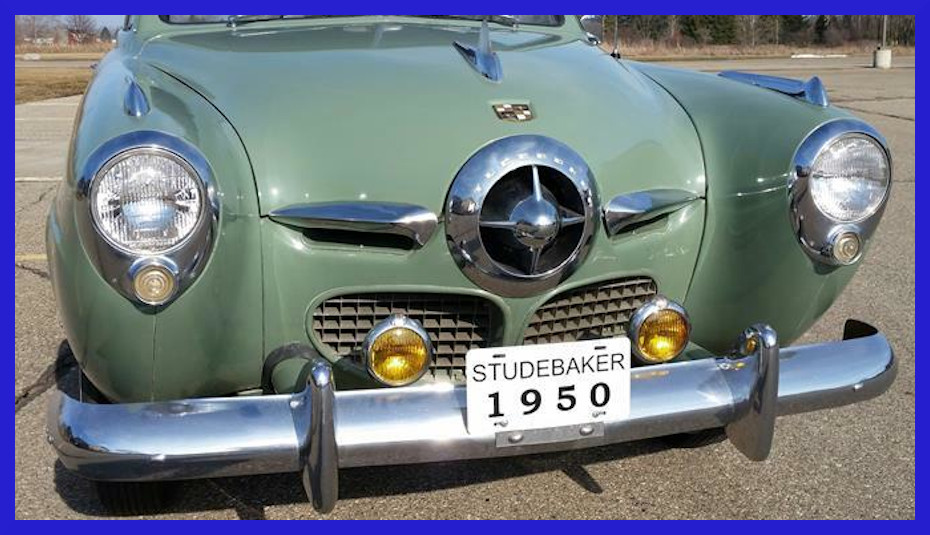
In the image to the right, the fender ornamentation is an accessory as are the fog lights. Note that the two lower grilles are recessed, they will be flush mounted next year. The hood ornament has a chrome part fitted with a lucite fin. The chrome hood lift handles with the finger holes under them will also be gone in 1951,
Exterior:
Exterior
changes are new badges, hood ornament, headlight rings, and
taillights. 1949 bumpers are used, but the front is mounted on
extended supports and encased in round tubes. The door handles are
smooth, the grooves seen in 1947 to 1949 are removed. A “Coat of
Arms” badge is placed in the hood, in the center, between the hood
ornament and the “Bullet”. The Studebaker name is stamped into
the bullet outer ring, with the model badge “Champion” on the
side of the front fenders. Smooth moon type hubcaps with “Studebaker
Champion” stamped the outer edge are new (later in the year, in
some cases, the name would be removed). A smooth moon style full
wheel cover with the “coat of Arms badge” in the center were optional.
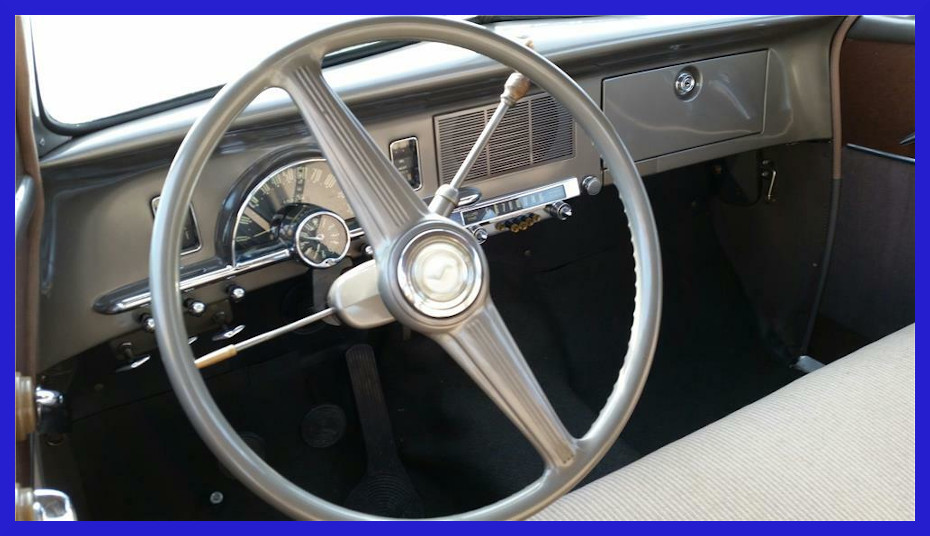
Interior: Interior
changes are a new dash, with the same basic layout. The instruments
are on the left, radio grille in the center, and glove box on the
right. The speedometer was a half moon design, with rectangular
minor gauges on either side. The optional clock is centered in the
lower portion of the speedometer surround, if installed, else this
area contained a gray bullet like blank. An upper dash cap extends
out over the main dash section, making the lower main section look
recessed.
Mechanical:
The
major mechanical change is front suspension, Planar system used since
1939 is gone. A more modern coil spring and A-arm arrangement, with
tubular shocks and and symmetrical steering is used (this would be a
one year only design). The wheelbase is one inch longer and the
engine compression is raised to 7.0 to 1, rated at 85 HP. Last, the
first fully automatic transmission is released at mid-year called
“Automatic Drive”, manufactured for Studebaker by Detroit Gear
division of Borg Warner and available in Champions as an option.
Mid-year
changes:
Painted headlight rings are now chrome on DeLuxe and
Regal models. The new Custom Series is made available. Plain hubcaps
(the lettering is removed) are seen on some models.
Model
Line-up:
The
exact same line-up seen in 1949 is initially seen. Coupe,
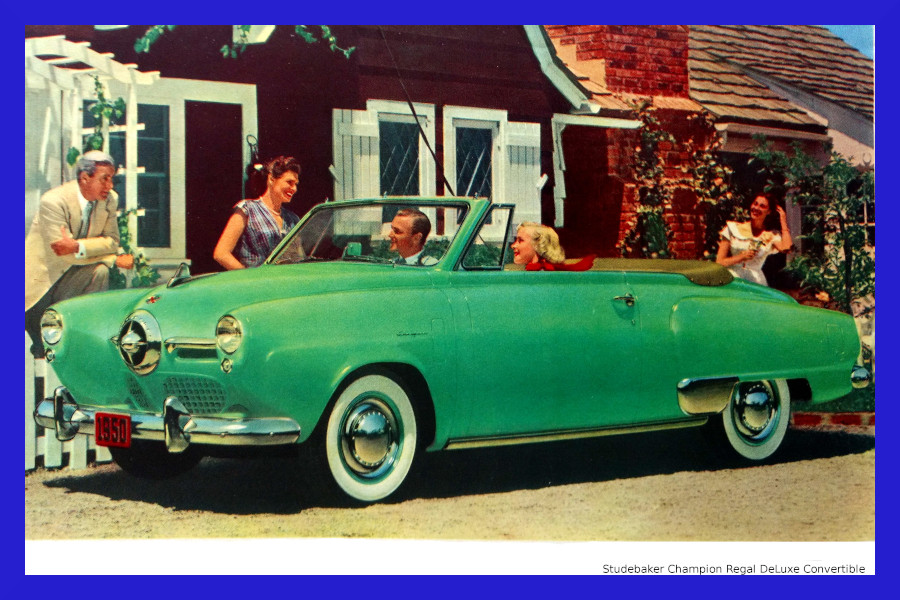 Starlight
Coupe, 2-dr Sedan, 4-dr Sedan, and Convertible (in Regal DeLuxe trim
only). However, at mid-year Studebaker would add the Custom trim
level. Starlight
Coupe, 2-dr Sedan, 4-dr Sedan, and Convertible (in Regal DeLuxe trim
only). However, at mid-year Studebaker would add the Custom trim
level.
Left Photo: Early DeLuxe two door sedan, rubber gravel guard, but painted headlight rims, later they will be chrome.
Right Photo: Regal DeLuxe Convertible
Left Photo: Regal DeLuxe Star-light coupe, note the stainless rocker trim.
Tells:
Custom
cars (spring release) have painted headlight rings, painted taillight bezels, do not
have a hood ornament or rubber/stainless steel gravel guards. The
interior fabric is very plain, no arm rests, one interior sun visor,
and a steering wheel borrowed from the 2R pickup. A new metal horn
button medallion, but no horn ring.
DeLuxe
trim is very similar to Regal DeLuxe. However, Regal DeLuxe has
stainless steel rocker panel moldings and better interior
appointments, Flat Wool cloth like Commanders and combination of
fabric and leatherette on the door panels. DeLuxe trim has Pile
cloth and single fabric door panels.
Commanders
are easy to tell from Champion's, look for the “Commander Emblems”
on the side of the front fenders, top front fender ornaments
(optional on Champions), a different hood ornament (winged chrome
piece with a round lucite spear), larger bumper guards, and three round
gauges in the dash. They also are also about ten inches longer from
the front doors to the nose.
Restoration
Information: (Source
TW October 1985)
Engine:
L-head
six, 169.6 cubic inches
Bore
& Stroke – 3” x 4”
Horsepower
– 85 @ 4000 prm
Compression
ratio – 7.0:1 (optional 7.5:1
Color
– Olive Green
Wheel
base: 113 inches
Tires:
6.40 x 15
Fuel
Tank: 18 gallons
|
1950 Closed Car
Body Colors |
|
Velvet Black |
Grove Green |
2Maui
Blue |
|
Concord Blue |
Aqua Green |
2Ojai
Green |
|
Midnight Blue |
Bermuda Green |
1Aero
Blue |
|
Black Cherry |
Tulip Cream |
1Old
Ivory |
|
Comanche Red |
Bahama Mist
Metallic |
1Shenandoah
Green |
|
Fiesta Tan |
Copper Mist
Metallic |
1Surf
Gray |
|
Falcon Gray |
Highland Mist
Metallic |
|
|
Plaza Gray |
2Aspen
Gray |
|
|
1950
Convertible Colors |
|
Velvet Black |
Copper Mist
Metallic |
Aqua Green |
|
Bahama Mist
Metallic |
Plaza Gray |
Bermuda Green |
|
Steel Mist Metallic |
1Old
Ivory |
Black Cherry |
|
Highland Mist
Metallic |
Tulip Cream |
Comanche Red |
|
|
|
Concord Blue |
|
1Spring
Color 2Color only used at Los Angeles Plant |
Early
color information limited the metallic paints to convertibles, but
later in-house “Paint Charts” booklets list all the metallics
except Steel Mist as being available on closed models. The “Paint
Chart” also gives detailed information on wheel and stripe colors.
1950
Studebaker Champion Series 9G, 113 in. wheelbase
|
1Model |
No. Doors |
Passengers |
2CCD Price |
1TW Price |
1No. Produced |
|
Custom Business Coupe (Q4) |
2 |
3 |
$1,419.00 |
$1,419.00 |
1,562 |
|
Custom Starlight Coupe (C1) |
2 |
5 |
$1,514.00 |
$1,514.00 |
3,583 |
|
Custom 2-dr Sedan (F1) |
2 |
6 |
$1,487.00 |
$1,487.00 |
19,593 |
|
Custom 4-dr Sedan (W1) |
4 |
6 |
$1,519.00 |
$1,519.00 |
16,000 |
|
DeLuxe Business Coupe (Q1) |
2 |
3 |
$1,482.00 |
$1,497.00 |
2,082 |
|
DeLuxe Starlight Coupe (C3) |
2 |
5 |
$1,572.00 |
$1,592.00 |
19,028 |
|
DeLuxe 2-dr Sedan (F3) |
2 |
6 |
$1,547.00 |
$1,565.00 |
45,280 |
|
DeLuxe 4-dr Sedan (W3) |
4 |
6 |
$1,577.00 |
$1,597.00 |
46,027 |
|
Regal DeLuxe Business Coupe
(Q2) |
2 |
3 |
$1,552.00 |
$1,576.00 |
849 |
|
Regal DeLuxe Starlight
Coupe (C5) |
2 |
5 |
$1,642.00 |
$1,671.00 |
29,966 |
|
Regal DeLuxe Convertible
(S2) |
2 |
5 |
$1,955.00 |
$1,981.00 |
9,362 |
|
Regal DeLuxe 2-dr Sedan
(F5) |
2 |
6 |
$1,617.00 |
$1,644.00 |
21,976 |
|
Regal DeLuxe 4-dr Sedan
(W5) |
4 |
6 |
$1,647.00 |
$1,676.00 |
55,296 |
|
Total |
270,604 |
|
1Serial
Numbers: |
|
Location |
Start |
End |
|
South Bend |
468,101 |
1,000,000 |
|
Los Angeles |
851,801 |
889,100 |
|
Canada |
709,400 |
724,500 |
|
1Engine
Numbers: |
|
South Bend |
521,001 |
778,000 |
|
Canada |
C-10,500 |
C-25,500 |
Source
Production & Serial Number: 1Turning Wheels
October 1985 2CCD
(Classic Car Database). Top of the Page
This
year Champions and Commanders will share the same sheet metal and the
same 115 inch wheelbase (exception Land Cruiser). It's possible
because of the new (much shorter) V-8 engine for the Commander. The
dash design will still be different between the two, at least for the
short term. This makes it much harder to tell the Champions from the
Commanders.
Exterior:
 Exterior
changes, the outer ring of the bullet is now sheet metal painted body
color, a second much narrower inner chrome ring is added to this
outer ring. Then a smaller chrome ring with a three blade molded
gray plastic spinner is placed in the center. The two grille
sections are larger and mount flush with the body sheet metal. The
tubes around the front bumper mounts are removed and replaced with a
metal apron that matched with the frontal sheet metal. The two holes
below the chrome hood handles and the handles themselves are gone. The trunk handle, hood ornament, and bumper guards are new. Plain
hubcaps and full wheel covers are used, with the “Coat of Arms”
full wheel covers available as on option. The taillight lens are
extended at the top. All models now have a single piece windshield. The sedans have a new single piece rear window.
Interior:
Interior
changes, the gauges and speedometer are encased inside a new
trapezoidal shaped glass enclosure 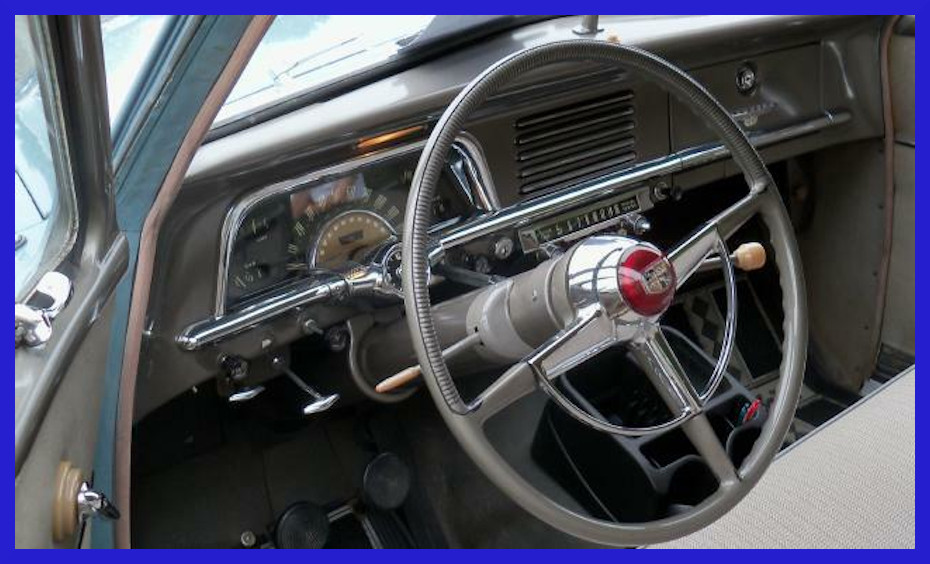 with a chrome surround. The
optional clock is removed from the gauge cluster, placed in it's own
separate enclosure, and mounted to the chrome strip under the gauge
cluster. The radio grille is now five slots stamped in the dash,
inserted with five chromed trim strips. The steering column is a
single tube enclosure with the shift and turn signal arms built into
the unit (except for Custom trim). There is a new steering wheel (three
spokes) and a new horn ring.
Mechanical:
Champions are changed to center point steering and wheels
now have five lugs per wheel. Electric windshield wipers are offered as optional equipment.
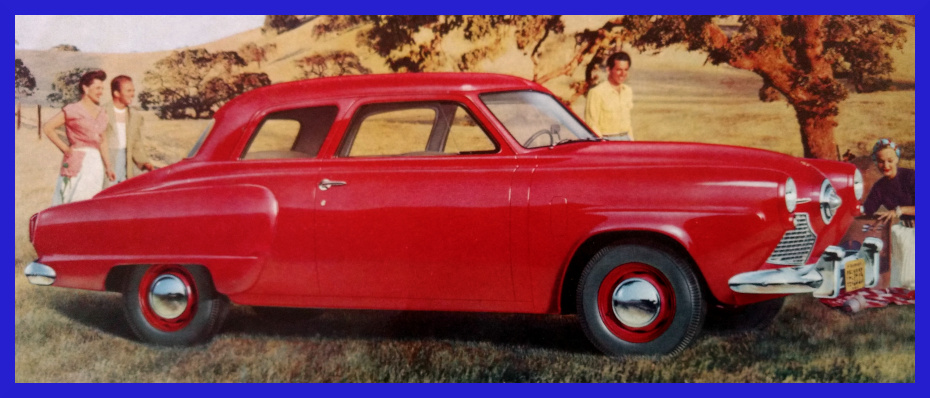 Model
Line-up: Model
Line-up: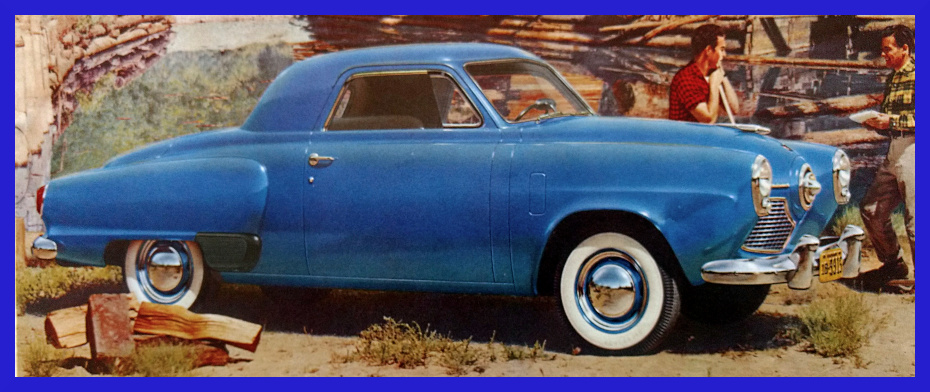 The
same model line-up from1950 is seen in 1951. Coupe, Starlight Coupe,
2-dr Sedan, 4-dr Sedan, and Convertible (in Regal trim only). The
Custom and DeLuxe trim levels are the 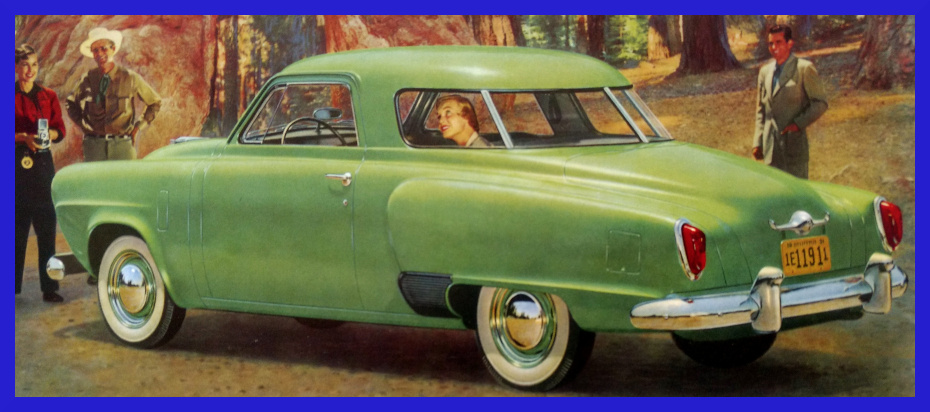 same, but the Regal DeLuxe trim
is now just Regal trim. 
Tells:
“Studebaker”
is removed from the bullet and placed on the drivers side of the
hood. “Champion” is placed on the passenger side. 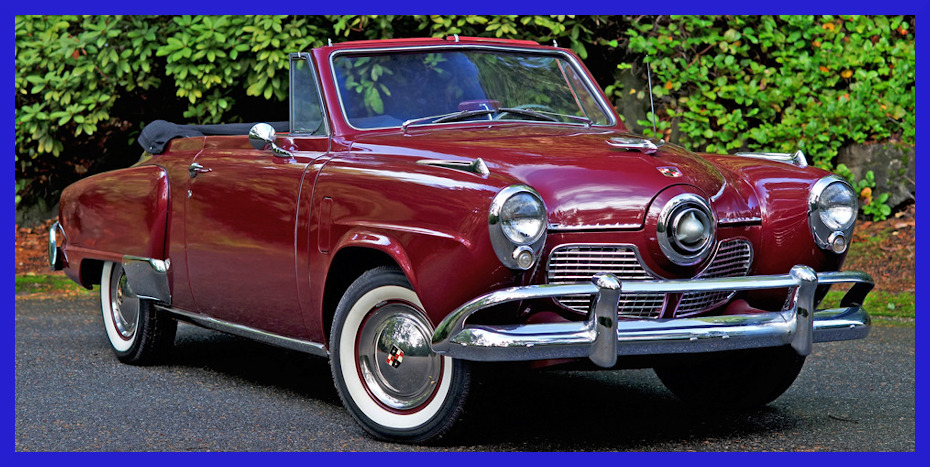 Both badges
are prominent die castings mounted to the lower edge of the hood. On
Champion's, the 1950 “Crest' emblem is still on the hood, just
below the new hood ornament (except Custom's which have no hood
ornament). The spinner is three blade gray plastic, 50 spinner is
chrome and has four blades and is much larger. Photos Top Left: Custom two door sedan - Top Right: DeLuxe Business Coupe - Middle Left: DeLuxe Starlight coupe - Middle Right: Regal four door sedan - Bottom Left: Regal convertible.
Restoration:
The
engine was painted olive green, electrical components were black,
the fan was black or olive green, and the air cleaner was black.
|
1951 Exterior
Colors |
|
1Velvet
Black |
1Shenandoah
Green |
1Plaza
Gray |
|
1Maui
Blue |
1Aqua
Green |
1Comanche
Red |
|
1Concord
Blue |
1Sahara
Sand |
1&3Black
Cherry |
|
1Rio
Green |
1Surf
Gray |
2Bermuda
Green |
|
2Midnight
Blue |
|
|
|
1South
Bend & Canadian Colors 2Additional Colors
available only in Canada 3Not available on
Custom. No metallic colors are used in 1951, no colors were
exclusive to convertibles, and no two-tones were available from
the factory except for fleet orders. CKD were often painted
non-factory colors. |
|
1951 Interior
Fabrics |
|
Trim |
Fabric |
|
Custom |
Bedford Cord |
|
DeLuxe |
Canda Pile Cloth |
|
Regal |
Woolen Flat Cloth |
|
Champion
Convertible (Regal) |
Nylon Cord with
leatherette |
|
Champion
Regal Convertible could be had with genuine leather at additional
cost. DeLuxe and Regal Champions had carpet in the rear with
black rubber in the front. Custom Champion's had black rubber
flooring both front and back, and Regal Convertible had carpet
both front and rear. |
Most
of the 1950 options and accessories were available for 1951 models,
the Philco eight-tube Stratoline radio's push buttons changed from
seven to six and Philco six-tube Starline radio's push buttons
changes from five to four. The Fram oil filter was made standard on
Land Cruiser (optional extra cost on all Champions).
1951
Studebaker Champion Series 10G, 115 in. wheelbase
|
Model |
2No.
Doors |
2Passengers |
2CCD
Price |
1TW
Price |
1No.
Produced |
|
Custom
business coupe (Q4) |
2 |
3 |
$1,370.00 |
$1,471.00 |
2,429 |
|
Custom
Starlight coupe (C1) |
2 |
5 |
$1,460.00 |
$1,566.00 |
2,781 |
|
Custom
2dr sedan (F1) |
2 |
6 |
$1,435.00 |
$1,540.00 |
10,689 |
|
Custom
4dr sedan (W1) |
4 |
6 |
$1,465.00 |
$1,571.00 |
9,972 |
|
DeLuxe
business coupe (Q1) |
2 |
3 |
$1,445.00 |
$1,549.00 |
961 |
|
DeLuxe
Starlight Coupe (C3) |
2 |
5 |
$1,535.00 |
$1,644.00 |
9,444 |
|
DeLuxe
2dr sedan (F3) |
2 |
6 |
$1,510.00 |
$1,618.00 |
18,591 |
|
DeLuxe
4dr sedan (W3) |
4 |
6 |
$1,540.00 |
$1,649.00 |
26,019 |
|
Regal
business coupe (Q2) |
2 |
3 |
$1,520.00 |
$1,628.00 |
373 |
|
Regal
Starlight coupe (C5) |
2 |
5 |
$1,610.00 |
$1,723.25 |
14,103 |
|
Regal
convertible (S2) |
2 |
5 |
$1,905.00 |
$2,034.00 |
4,742 |
|
Regal
2dr sedan (F5) |
2 |
6 |
$1,585.00 |
$1,697.00 |
8,931 |
|
Regal
4dr sedan (W5) |
4 |
6 |
$1,615.00 |
$1,728.00 |
35,201 |
|
Total |
144,236 |
Source: 1TW
December 1985 2Classic
Car Database (CCD)
|
Serial
Numbers |
|
Location |
Start |
End |
|
South
Bend |
1,000,000 |
1,115,500 |
|
Los
Angeles |
889,101 |
907,300 |
|
Canada |
724,510 |
735,700 |
|
Engine
Numbers |
|
Location |
Start |
End |
|
South
Bend |
778,001 |
911,500 |
|
Canada |
C-25,501 |
C-36,721 |
|
Mechanical |
|
Description |
Specification |
|
L-head
Six |
169.6
Cubic Inches |
|
Bore
& Stroke |
3”
by 4” |
|
Horsepower |
85
@ 4,000 rpm |
|
Compression
Ratio |
7.0:1
optional 7.5:1 |
|
Carburetor |
Carter
model WE-715S |
|
Tires |
6.40x15
tube type |
|
Fuel
Tank |
18
gallons |
Interesting,
I asked, how did we get from 10G Champion in 1951 to 12G Champion for
1952 what happened to 11G? Well, that number was assigned to the all
new Model “N” car which had been in the design process, including
clay models, prototypes, and actual road testing, until then they
were not. The N Models would have had all new sheet-metal and
included some form of the bullet nose theme. The Model N died over
uncertainty about the Korean War. The last minute cancellation,
caused Studebaker to rush another face lift of the existing 1947
through 1951 cars, to create the 1952 Studebaker's. Between the
Bullet-Nosed Studebaker's and the all new 1953 Studebaker, the 1952
seem like the all but forgotten year. However in this writers
opinion that 1952 Starliner is still one of the most stunning
Studebaker's ever created.
Exterior:
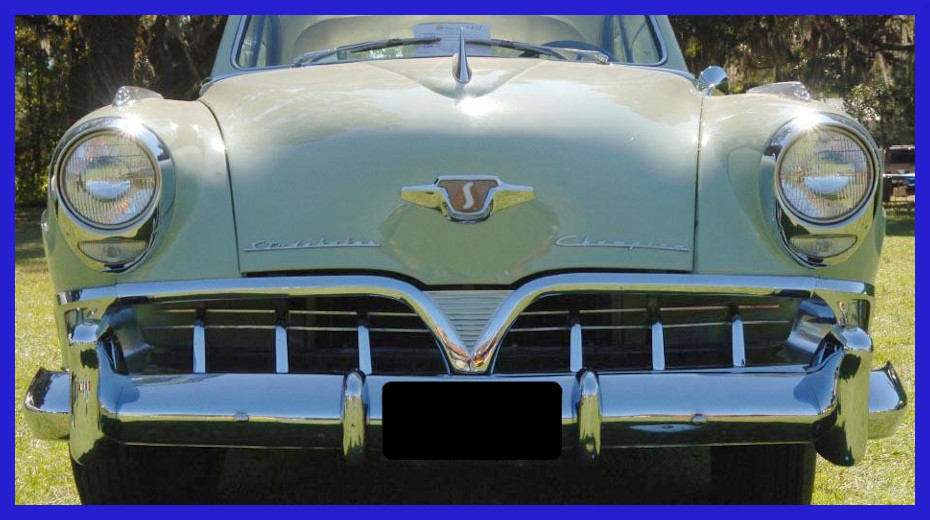 As
was the case in 1950, the 1952 face-lift happens most significantly
from the cowl forward. The bullet-nose theme is dropped and a very
elegant new horizontal grill design is developed. It consists of two
end caps, a top bar with a deep “V” in the center, and a bottom
bar with six vertical teeth, three on each side of the “V”. Then
somehow, much thinner horizontal bars are attached in the background. No bullet-nose, needs a new hood to go with the new grille. Also
modified front fenders are fitted with newly designed headlight rims. The front bumper is fitted with four bumper guards, two large on the
outside and two smaller ones flanking the license plate holder. Studebaker Champion name plates are used on the leading edge of the
hood, but no name plates would be seen on the side of the fenders for
any models in 1952.  Deluxe and Regal have a new hood ornament (far right photo) which
they share with the Commander. In 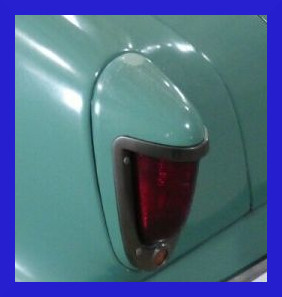 the rear, we get new taillights
(left photo) with hooded bezels (the last glass taillight lens) and a new deck lid
handle (except for Custom trim). Champion's have no name badge on the rear deck lid. 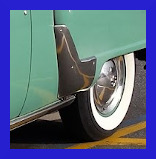 The
stainless steel gravel guard seen on the Champion Regal convertible and
hardtop is redesigned with the leading edge extending much higher and
the convertible back glass is now a larger single pane vinylite
affair.
Interior:
Very
few interior changes are made for the 1952 models. The instrument
panel is slightly modified. The Automatic Drive cars get a push
button starter switch. Expect few if any Champions were equipped
with this optional automatic transmission. The Regal Champion's get
a new horn ring and feature a non-round horn button unique to 1952.
Mechanical:
The
only significant mechanical change for 1952 Champions was that the
brakes are redesigned.
Model
Line-up:
Nearly
the same model line-up from1951 is seen in 1952. Starlight Coupe,
2-dr Sedan, 4-dr Sedan, and Convertible (Regal trim only). Trim
levels remain as Custom, DeLuxe, and Regal. However, gone are the Custom, DeLuxe, and Regal three-passenger coupes.
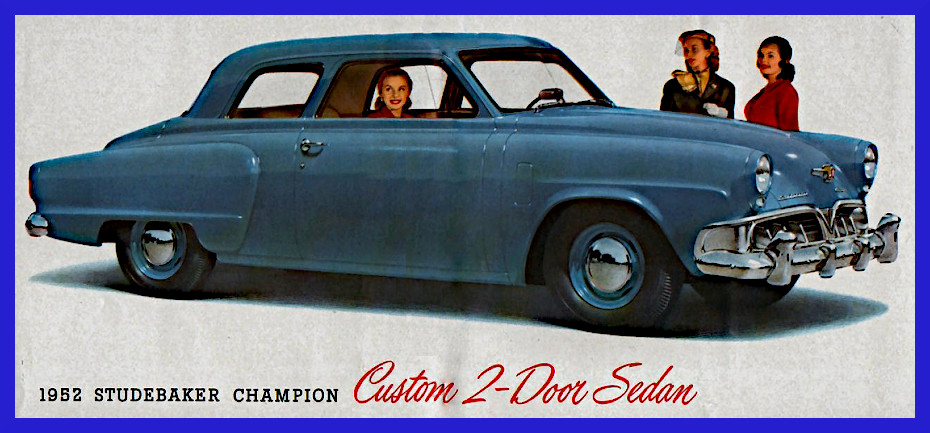 Left Photo: A new hardtop
called the Starliner is released in Regal trim only.
Right Photo: Starlight coupe in DeLuxe trim.
Left Photo: Two door Sedan in Custom trim, no gravel guard and painted headlight rims.
Right Photo: Convertible in Regal trim.
Tells:
In
the 1950 to 1952 Studebaker series 52 would be the only year without
a bullet nose, making them very easy to identify. The deep “V”
in the grille is a significant tell for 52's and a sign of what the
future was going to bring. We know that Champion's and Commander's
are running on the same wheel base and use the same sheet-metal
(except the Land Cruiser). So, in the front look for the Champion
script on the lower edge of the hood and from the rear look for the
“Commander” or “Land Cruiser” deck lid name plate, if you
don't find one it has to be a Champion (Champion's had no rear deck
lid name plate). From the side no known tells. Custom trim only
exists for Champion, so look for a car without a hood ornament or a
side gravel shield, with painted headlight rims and taillight
bezels. If the car has a rubber gravel shield, it may be a DeLuxe trim
car, but if the gravel shield is rubber and it has a stainless steel
rocker panel mounding your looking at a Regal trim (closed car) Champion.
Restoration:
Champion
engine block, head, fan, and pan were painted olive green, however
sometimes the fan was black. The air cleaner, generator, starter,
coil, voltage regulator, spark plug wire brackets, and horn relay
were black. Item in natural color were carburetor, fuel pump, and
overdrive relay. The radiator and upper radiator air deflector were
black. The hood lock plate assembly was unpainted. Oil filters
factory installed were black with a bare metal top bolt (most likely
had olive over spray). Dealer installed were generally from Fram and
were orange body with black lid and sometimes with a black mounting clamp.
|
1952 Exterior Solid
Colors (no metallics) |
|
Color |
Wheel Color |
Canadian Wheel
Color |
|
Velvet Black |
Comanche
Red |
Cuban
Red |
|
Maui
Blue |
Cuban
Red |
Cuban
Red |
|
2Concord
Blue |
Concord
Blue |
Concord
Blue |
|
Nocturne
Blue |
Nocturne
Blue |
Nocturne
Blue |
|
Surf Gray |
Comanche
Red |
Cuban
Red |
|
Piedmont Gray |
Comanche
Red |
Cuban
Red |
|
Sahara
Sand |
Sahara
Sand |
Sahara
Sand |
|
Cuban Red |
Comanche
Red |
Cuban
Red |
|
Rio
Green |
Sahara
Sand |
Sahara
Sand |
|
Aqua
Green |
Aqua
Green |
Aqua
Green |
|
1Bermuda
Green |
---------- |
Sahara
Sand |
|
1This
color was only available in Canada for 1952. 2This
color may not have been available from Los Angeles. Starlight
Hardtop were not normally painted a single solid color, but
perhaps could have been special ordered that way. |
|
1952 Exterior
Two-Tone Colors (no metallics) Only available on Starliner Hardtop |
|
Upper Color |
Lower
Color |
Wheel Cover |
|
Spartan
Rust |
Sahara
Sand |
Sahara
Sand |
|
Corning
Olive |
2Sahara
Sand |
Sahara
Sand |
|
Nocturne
Blue |
2Sahara
Sand |
Sahara
Sand |
|
Shell
Ivory |
2Maui
Blue |
Nocturne
Blue |
|
Nocturne
Blue |
Maui
Blue |
Nocturne
Blue |
|
Venice
Red |
Surf
Gray |
Comanche
Red |
|
London
Gray |
2Surf
Gray |
Comanche
Red |
|
Nocturne
Blue |
Surf
Gray |
Comanche
Red |
|
London
Gray |
Tahoe
Green |
Sahara
Sand |
|
Walnut
Brown |
2Rio
Green |
Sahara
Sand |
|
Shadow
Green |
Rio
Green |
Sahara
Sand |
|
Wheel did not have
stripes in 1952. Those cars shipped with full wheel covers
normally came with black wheels. It is possible that the black
wheel/full wheelcover combination was limited to cars with
white wall tires. 2These
color may not have been available from Los Angeles. |
|
1952 Interior
Fabrics |
|
Trim |
Fabric |
|
Custom |
Bedford Cord |
|
DeLuxe |
Pile & Cord |
|
Regal Sedan and
Starlight Coupe |
Woolen Flat Cloth |
|
Regal Convertible
and Starliner |
Nylon Cord with
leatherette |
|
Regal
Convertible and Starliner could be had with genuine leather and
leatherette at additional cost. Regal has carpet in the rear with
black rubber in the front. Custom & Deluxe have black rubber
flooring both front and back. All Regal Champion Convertible and
Starliner have carpet both front and rear (Ref. Body Parts
Catalog 1951 – 1952 Series February 15, 1952). |
1952
Studebaker Champion Series 12G, 115 in. wheelbase
|
Model |
2No.
Doors |
2Passengers |
2CCD
Price |
1TW
Price |
1No.
Produced |
|
Custom
Starlight coupe (C1) |
2 |
5 |
$1,477.00 |
$1,763.00 |
1,096 |
|
Custom
2dr sedan (F1) |
2 |
6 |
$1,452.00 |
$1,735.00 |
4,310 |
|
Custom
4dr sedan (W1) |
4 |
6 |
$1,482.00 |
$1,769.00 |
6,400 |
|
DeLuxe
Starlight Coupe (C3) |
2 |
5 |
$1,553.00 |
$1,856.00 |
6,075 |
|
DeLuxe
2dr sedan (F3) |
2 |
6 |
$1,527.00 |
$1,828.00 |
12,989 |
|
DeLuxe
4dr sedan (W3) |
4 |
6 |
$1,558.00 |
$1,862.00 |
24,542 |
|
Regal
Starlight coupe (C5) |
2 |
5 |
$1,629.00 |
$1,941.00 |
6,183 |
|
Regal
convertible (S2) |
2 |
5 |
$1,927.00 |
$2,273.00 |
1,575 |
|
Regal
Starliner hardtop (K2) |
2 |
5 |
? |
$2,220.00 |
12,119 |
|
Regal
2dr sedan (F5) |
2 |
6 |
$1,603.00 |
$1,913.00 |
5,534 |
|
Regal
4dr sedan (W5) |
4 |
6 |
$1,634.00 |
$1,946.00 |
20,566 |
|
Total |
101,389 |
Source: 1TW
August 1994 2Classic
Car Database (CCD)
|
Serial
Numbers |
|
Location |
Start |
End |
|
South
Bend |
1,115,501 |
1,197,500 |
|
Los
Angeles |
907,301 |
917,700 |
|
Canada |
735,701 |
745,100 |
|
Engine
Numbers |
|
Location |
Start |
End |
|
South
Bend |
911,501 |
1,004,000 |
|
Canada |
C-36,722 |
C-46,500 |
|
Mechanical |
|
Description |
Specification |
|
L-head
Six |
169.6
Cubic Inches |
|
Bore
& Stroke |
3”
by 4” |
|
Horsepower |
85
@ 4,000 rpm |
|
Compression
Ratio |
7.0:1
optional 7.5:1 |
|
Carburetor |
Carter
model WE-715S |
|
Tires |
6.40x15
tube type |
|
Fuel
Tank |
18
gallons |
|